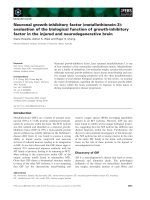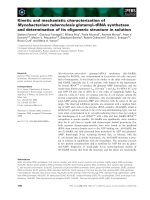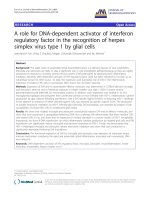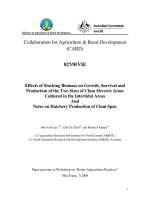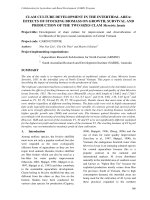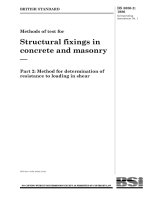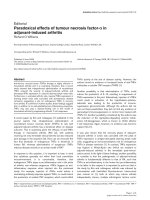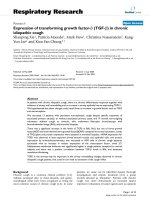Determination of mercury accumulation factor in hard clam (meretrix lyrata) at bach dang estuary, viet nam
Bạn đang xem bản rút gọn của tài liệu. Xem và tải ngay bản đầy đủ của tài liệu tại đây (359.71 KB, 7 trang )
Environment and Natural Resources Research; Vol. 6, No. 3; 2016
ISSN 1927-0488
E-ISSN 1927-0496
Published by Canadian Center of Science and Education
Determination of Mercury Accumulation Factor in Hard Clam
(Meretrix lyrata) at Bach Dang Estuary, Viet Nam
Le Xuan Sinh1
1
Institute of Marine Environment and Resources, Viet Nam Academy of Science and Technology, Viet Nam
Correspondence: Le Xuan Sinh, Institute of Marine Environment and Resources, Viet Nam Academy of Science
and Technology, Viet Nam. E-mail:
Received: May 5, 2016
doi:10.5539/enrr.v6n3p18
Accepted: May 17, 2016
Online Published: July 19, 2016
URL: />
Abstract
Bach Dang estuary (Hai Phong City) is one of the developed economic centers of Hai Phong city with
abundance of natural resources. At the Bach Dang estuary, waste sources of mercury compounds discharge from
the industrial sources, transportation sources, port, agricultural sources and living sources. Two forms of
mercury: total mercury and methyl mercury in the water at the Bach Dang estuary are lower than the allowable
limit. Bioaccumulation factor (BAF) of total mercury in hard clam Meretrix lyrata is 307 and that one of methyl
mercury is 165,000.
Keywords: accumulation coefficient, hard clam (Meretrix lyrata), mercury
1. Introduction
Biological accumulation is defined as a biological process in which organism directly store chemicals from the
abiotic environment (water, air and soil) and from food sources (food transmission). The chemicals in the
environment are absorbed through passive diffusion process. The first organ for the absorption includes pleural,
gills and intestines. The chemicals must penetrate the lipid bilayer of the membrane to enter the body. Potential
bioaccumulation of the chemicals relates to the solubility of the substances in the lipid. Aquatic environment is
the place that the affinity with lipid substances through barrier between the natural environment and living
organisms. Because rivers, lakes and oceans as substances settling tank and aquatic organisms move large
amounts of water through their respiratory membrane, allow a number of chemical separated from water in the
body. Aquatic organisms can biologically accumulate chemicals and reach higher concentrations in the
environment.
In the coastal environment, the bottom layer living molluscs group were selected by scientists to be the study
subjects due to high bioaccumulation, sedentary life, organic humus filter eating, etc. It also comes with the risk
of losing safe for humans to use them as food if the toxicity levels (eg heavy metal group, persistent organic
group) accumulate in tissues and internal organ large enough. The bottom layer living molluscs group has met
the conditions for studying, such as sedentary life, capable of accumulating pollutants, long life enough, sizes
suitable to provide sufficient tissue for analysis service and easy sampling. In fact, it is hard to get any species
that meets all the criteria. Bivalve mollusks have the ability to accumulate pollutants many times higher than in
the water environment, food and sedentary filter, they are usually chosen as the indicator organisms, the study
object in the field environmental toxicology.
Bach Dang estuary (Hai Phong City) is one of the developed economic centers of Hai Phong city with
abundance natural resources (Thanh, An, & Trang, 2014). The tidal plains formed on both sides of the Bach
Dang River area due to the interaction between flow in river and coastal river. There, the nutrients from the
estuary are favorable conditions for aquaculture, especially clam aquaculture (Le Xuan, Duc, & Kim, 2011). At
the Bach Dang estuary, the mercury discharge sources from the same industrial sources (power plants, steel
plants, electronic plants and cement plants), traffic sources, port, agricultural sources and living sources (Le
Xuan, 2015). Research mercury bioaccumulation factor of Ben Tre white clam species (Meretrix lyrata) helps
assess the mercury accumulation process in the environment to go into the living organisms here.
18
www.ccsenet.org/enrr
Environment and Natural Resources Research
Vol. 6, No. 3; 2016
2. Object and Method of Research
2.1 Research Object
- Sampling subject is Ben Tre hard clam (Meretrix lyrata) with commercial size (size may be sold on the market)
in Dong Bai commune (Cat Hai district of Hai Phong city).
- Mercury total and Metyl Mercury in water and tissue of Meretrix lyrata at Bach Dang estuaty from July 27th,
2010 to May 6th, 2011.
Figure 1. Ben Tre hard clam (Meretrix lyrata)
Area of tidal flat for
distribute hard clam
(Meretrix lyrata): 155,5ha
Sampling Station
Figure 2. Diagram of onsite sampling
2.2 Research Method
Mercury analysis in water and organism
+ Analysis of total mercury in water by the method of EPA 1631e (EPA, 2002).
+ Total mercury concentration in biological tissue (EPA, 2002).
19
www.ccsenet.org/enrr
Environment and Natural Resources Research
Vol. 6, No. 3; 2016
In this study, the detection limit of the method is determined according to 09 times repeat sample test results of
standard solution at a concentration of 0.5µg/l. According to this result, the average measured result is 0.51μg/l,
the standard deviation S is 0.03 µg/l, the recovery is 102%. It shows that the precision and focus of the analytical
results. Ts value correspond to 99% probability measurement number (n = 9) is 3.36, which determine the
method detection limit MDL = Sxts = 0.12 µg/l.
To assess the accuracy of the method, we had used the following standard samples: standard sample of sediment
MESS-3 of Canadian with the determined concentration is 0,091 µg/g ± 0,009. The result of measuring MESS-3
sample in the laboratory of Institute of Marine Environment and Resources (n = 4) is 0,101 µg/g ± 0,012,
analysis deviation compared with standard sample was 108%. It indicated that the analysis method of total
inorganic mercury met the requirement for the analysis of environmental samples.
2.3 The Bioaccumulation Factor (BAF) Calculation Method
Bioaccumulation factor (BAF) is the ratio of substance concentration in tissues of living organisms to the
concentration of the substance in the water environment (Arnot & Gobas, 2006).
BAF =
Ct
(1.1)
Cs
In which:
- BAF is calculated by experimental data
- Ct is the pollutant concentration in biological tissues (mg/kg dry tissue)
- Cs is the pollutant concentration in water (mg/l)
3. Research Result and Discussion
Clam samples were collected 10 times per year to analyze total mercury and methyl mercury concentration in
clam tissue. The water samples were collected 10 times and analyzed the concentration of total mercury and
methyl mercury. The analytical result for the repeat sample (n = 5) has shown in Table 1.
Table 1. The results of the mercury analysis in water environment and clam tissue
Sample time
Series 1: 1st sampling (27 July,
2010) (n=5)
Series 2: 2nd sampling (29
August, 2010) (n=5)
Series 3: 3rd sampling (27
September, 2010) (n=5)
Series 4: 4th sampling (30
October, 2010) (n=5)
Series 5: 5th sampling (4
December, 2010) (n=5)
Series 6: 6th sampling (5
January, 2011) (n=5)
Series 7: 7th sampling (27
January, 2011) (n=5)
Series 8: 8th sampling (4
March, 2011) (n=5)
Series 9: 9th sampling (8 April,
2011) (n=5)
Series 10: 10th sampling (6
May, 2011) (n=5)
Total mercury
Methyl mercury
HgT in clam
tissue (ng/g)
HgT in water
(µg/l)
HgMe in clam
tissue (ng/g)
HgMe in water
(ng/l)
12.5
0.61
1.1
0.18
24
0.52
7
0.16
35
0.23
8.5
0.12
37.9
0.36
10.45
0.18
57.85
0.31
10.75
0.16
47.1
0.30
13.65
0.15
31.8
0.35
14.05
0.18
53.7
0.25
15.1
0.13
84.85
0.28
23.1
0.14
87.9
0.77
24.55
0.23
n: sample per time to survey.
20
www.ccsenet.org/enrr
Environment and Natural Resources Research
Vol. 6, No. 3; 2016
3.1 Assessing the Evolution of Mercury Concentration in Water
0.6
0.9
HgT
Hg-Me
0.4
0.6
0.2
0.3
0
Series1 Series 2 Series 3 Series 4 Series 5 Series 6 Series 7 Series 8 Series 9 Series10
Concentration Hg- Me (ng/l)
Concentration HgT (ug/l)
According to the analysis result in Table 1, the concentration of total mercury and methyl mercury were shown
in diagrams 3. Total mercury concentration fluctuated in the range of 0.25 ữ 0.77 àg/l in 10 sampling times. It
showed that the mercury concentration in the rainy season (June, July, August and next May) is higher than in
the dry season (from September to next April). Methyl mercury concentration ranged in 0.12 ÷ 0.23 ng/l in 10
sampling times. The trend of methyl mercury was not clear as the trend of total mercury. The concentration of
methyl mercury in seawater was small, get only 0.03 ÷ 0.05% of the mercury concentration. Although methyl
mercury concentration in water environment was small in comparison with the total mercury concentration, its
toxicity is very high if it enters the organism and human body. Methyl mercury is the most toxic form of mercury.
Methyl mercury is soluble in fat or lipid component of the brain membranes, accumulates in cells with long life.
Methyl mercury can be transported from mother to child when the mother poisoned. Methyl mercury
accumulated in seafood because it can not be disposed in the seafood processing due to methyl mercury tightly
bound to proteins in the cell. 95% of methyl mercury absorbed into the organs of the fish after 2 days and exist in
the fish body from 70 ÷ 90 days (Eisler, 2006). Therefore, methyl mercury will go into the human body through
eating fish, cause Minamata disease in Japan (lost control CNS) if the body absorbed an amount of methyl
mercury higher than 0,1μg/kg/day (EPA, 1997b).
0.0
Figure 3. Performance of HgMe and HgT concentration over time
3.2 Assessing the Mercury Concentration Accumulated in Clam Meat Tissue
n g /g
Mercury from the water accumulated in organisms in general and in particular white clam species. The mercury
concentration accumulation in clam depends on the different times in a year. The data of total mercury and
methyl mercury accumulated in clam meat tissue shown in Figure 4.
100
80
Concentration Hg-T (ng/g)
Concentration HgMe (ng/g)
60
40
20
0
Series 1 Series 2 Series 3 Series 4 Series 5 Series 6 Series 7 Series 8 Series 9 Series 10
Figure 4. Performance of HgMe and HgT concentration in clam meat tissue over time
21
www.ccsenet.org/enrr
Environment and Natural Resources Research
Vol. 6, No. 3; 2016
According to Figure 3, the trend of total mercury concentration accumulation in the meat tissue increased from
the 1st sample to the 5th sample (from July to December), then reduced from the 5th sample to 7th sample. It was
in January, the coldest month in the year. In this period, the total mercury accumulation in meat tissue decreased
due to the elimination process larger than the accumulation process. In winter, temperatures are around 15°C, the
wave and flow regime in clam aquaculture place is strong because it is affected by the northeast monsoon.
Therefore, the clam should often bury themselves in the sand to cope with the extreme weather, clam fat is
reduced due to the lack of food. At this time, because of strong sea waves, the clams must spend a portion of
energy to fix on the sand by foot (Phu, 1999). When the clams bury themselves in the sand, they use the stored
energy which accumulated in fat tissue, the analysis data showed that the lipid concentration in clam tissue in 6th
and 7th sample decreased (Le Xuan, 2015). The loss of lipid can lead to release lipid soluble toxin and eliminate
mercury mount accumulated in the fat tissue out (Tuan, 2008). Then, the total mercury accumulation in tissue
increased from the 7th sample to 10th sample, corresponding to the period from March to May. It was the spring
time, food abundant so the clam thrives. Spring is also time of recording the study result of mercury
accumulation level increase gradually over time. The accumulation speed is different over time.
HgMe concentration accumulates much in adipose tissue. However, when reduce the amount of lipid content in
tissue, HgMe still up, it showed that the sustainability of the mercury form as methyl mercury tightly bound to the
protein in muscle cell in clam body and organism body in general (EPA, 1997a). Acccumulated methyl mercury
concentration in clam meat tissue tended to rise. It increased from 106% ÷ 127%, particularly in the 2nd sample,
it increased 636% in comparison with the 1st sample. The average proportion of methyl mercury accounted for
26%, similar to the study result of some bivalve molluscs distributed in Rio de Janeiro estuaries in Brazil (Kehrig,
Costa, Moreira, & Malm, 2001). To assess the maximum mercury accumulation of clam through sampling times,
it is necessary to be based on the bioaccumulative factor of mercury forms.
3.3 Bioaccumulation Factor of Total Mercury and Methyl Mercury
Calculating bioaccumulation factor is according to the formula 1.1, the result of bioaccumulation factor (BAF) of
total mercury and methyl mercury are shown in Table 2.
Table 2. Bioaccumulation factor (BAF) of mercury forms
Series
BAF of HgT
BAF of Hg Me
Series 1
21
6,011
Series 2
46
44,872
Series 3
149
73,913
Series 4
105
58,056
Series 5
185
69,355
Series 6
159
91,000
Series 7
90
80,286
Series 8
217
120,800
Series 9
307
165,000
Series 10
114
106,277
Bioccumulation factor of both types of mercury (methyl mercury and total mercury) in 9th sampling was very
high. The BAF of total mercury was 307 and that one of methyl mercury was 165,000. The highest
bioaccumulation factor (BAF) of two types of mercury is always in April - this is the time for clam harvest at
Bach Dang estuary. Thus, the clam sampled was in the time when accumulated mercury was the highest. This is
also the clam’s fattest time in a year. Then, the clams are arrested for rehabilitating beach for the next season.
The BAF of clam and cockle (Anadara granosa) are equivalent because of their similarity of distribution, size
and breeding process. BAF of HgT of cockle (BAFT = 355, this is the research result of topic coded
VAST06.07/11-12) is not much different in comparison with clam (BAFT = 307).
Currently, the studies on mercury accumulation in the clam Meretrix lyrata tissue still lack, or have but the
monitoring data on the clam and environment samples is heterogeneous. According to the data in March 2011 of
22
www.ccsenet.org/enrr
Environment and Natural Resources Research
Vol. 6, No. 3; 2016
the North coast station, the data on total mercury in the clam intestine and in the environment in Sam Sơn region
(Thanh Hoa) and Cua Lo region (Nghe An) (Monitoring and environmental analysis stations in Coastal Northern
Viet Nam, 2011). The monitoring data in March coincided with the time of clam harvesting in the Bach Dang
estuary. BAF has been transformed in correspondence with the size of the clam collected at Sam Son and Cua Lo
region, BAF of the clam farmed in the Bach Dang estuary has been calculated according to the mercury
concentration of the stomach and tissue. After converted into the BAF of clam farmed in the Bach Dang estuary
in correspondence with the size of clam farmed in the Sam Son and Cua Lo region, we recognize that BAF is
different. BAF of the clam farmed in the Bach Dang estuary is higher than in Sam Son region 130% and lower
than in Cua Lo region 76% (Figure 5).
BAF
Cua Lo
180
160
140
120
Bach Dang
Bach Dang
Sam Son
100
80
60
40
20
0
To compare BAF of Meretrix
lyrata in Sam Son Beach and
Bach Dang estuary
To compare BAF of Meretrix
lyrata in Cua Lo Beach and
Bach Dang estuary
Figure 5. Comparison of the bioaccumulation factor BAF of clam in Bach Dang estuary, Sam Son and Cua Lo
beach
Thus, the mercury accumulation of hard clam Meretrix lyrata in various areas is different. It depends on the
geographic partition. Currently, the data for the comparison with clam mercury accumulation in the south is not
enough. This is one of the contents that the author need to research more in the future.
4. Conclude
Two forms of mercury are defined as total mercury and methyl mercury in the water environment are lower than
the allowable limit. In a clam meat tissue, total mercury accumulation ranged from 12.5 to 87.9 ng/g dry.
Mercury concentration accumulation increased from feeding until December, then reduced in January and
increased from harvesting in May. Methyl mercury accumulation increased from feeding until harvesting,
fluctuated in the range of 1.1 to 24.6 ng/g dry. Bioaccumulation factor of total mercury of clam Meretrix lyrata
is 307 and BAF of methyl mercury is 165,000. The mercury accumulation in hard clam Meretrix lyrata in the
Bach Dang estuary, Sam Son and Cua Lo beach is different, so BAF is different, it depends on the environmental
conditions of each region.
Acknowledgements
The author would like to express thanks to the program "Young staff in 2016" of the Vietnam Academy of
Science and Technology of and project, VAST 06.05/16-17 has supported author to implement this research.
Reference
Arnot, J. A., & Gobas, F. A. (2006). A review of bioconcentration factor (BCF) and bioaccumulation factor
(BAF) assessments for organic chemicals in aquatic organisms. Environmental Reviews, 14(4), 257-297.
Eisler, R. (2006). Mercury hazards to living organisms. CRC Press.
23
www.ccsenet.org/enrr
Environment and Natural Resources Research
Vol. 6, No. 3; 2016
EPA. (1997a). Fate and transport of mercury in the environment. Mercury study report to congress (Vol III,
Epa-452/r-97-005). Office of air quality planning & standards and office of research and development.
Environmental Protection Agency, USA.
EPA. (1997b). Intake of Fish and Shellfish. Food Ingestion Factors (Vol II, Chapter 10).
EPA. (2002). Method 1631, method 1630e: Mercury in water, sediment, tissue by Oxidation, Purge and Trap,
and Cold vapor Atomic Flourescence Spectrometry. Environmental Protection Agency, USA.
Kehrig, H. D. A., Costa, M., Moreira, I., & Malm, O. (2001). Methylmercury and total mercury in estuarine
organisms from Rio de Janeiro, Brazil. Environmental Science and Pollution Research, 8(4), 275-279.
Le Xuan, S. (2015). Study compound of Mercury in water at Bach Dang’s Estuary. Journal of Science and
Technology, 53(2), 373-380.
Le Xuan, S., Duc, T. T., & Kim, C. D. (2011). Study on Growth’s Rule of Hard Clam (Meretrix lyrata) in Bach
Dang Estuary, Viet Nam. Environment and Natural Resources Research, 1(1), 139-151.
Monitoring and environmental analysis stations in Coastal Northern Viet Nam (2011). The General Department
of Environment, Ministry of Natural Resources and Environment.
Phu, T. Q. (1999). Study on some biological characteristics, biochemical and farming techniques Meretrix lyrata
clam (Sowerby). PhD thesis, University of Can Tho.
Thanh, T. D., An, L. D., & Trang, T. M. (2014). Estuarine areas in hai phong city - position resources. Journal of
Science and Technology, 14(2), 110-121.
Tuan, L. Q. (2008). Environmental Tocixcity (Chapter II, pp. 6-7). Faculty of Environment and Natural
Resources, Ho Chi Minh Agriculture and Sylvicultyre University.
Copyrights
Copyright for this article is retained by the author(s), with first publication rights granted to the journal.
This is an open-access article distributed under the terms and conditions of the Creative Commons Attribution
license ( />
24
